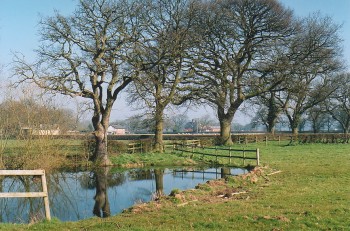
Cymraeg / English

|
Maelor Saesneg Historic Landscape |

|
Character area map |
Historic Landscape Characterisation
Maelor Saesneg:
Higher Lanes
Bronington and Willington Worthenbury communities, Wrexham County Borough
(HLCA 1126)
 Dispersed farms on lanes running between strip fields and ridge and furrow of medieval open field origin.
Dispersed farms on lanes running between strip fields and ridge and furrow of medieval open field origin.
Historic background
Early medieval settlement of perhaps the 8th to 10th century is suggested by the place-name Tybroughton ending with the Old English element -tun.Key historic landscape characteristics
Gently undulating landscape, generally between 30-90 metres above Ordnance Datum, with watercourses and streams such as the Shoothill Brook running to the north to join the Wych Brook.Fieldscapes are dominated by strip fields and reorganised strip fields, associated with a relatively high proportion of ridge and furrow, derived from medieval open field cultivation, with narrow lanes running between the fields. The numerous marl pits scattered across the area, now generally visible as ponds, probably represent post-enclosure land improvement. Modern land-use is predominantly pasture, field being bounded by mature mixed-species hedges and post and wire fences. Mature oak trees are scattered along existing hedgerows as well as denoting the course of former field boundaries across enlarged fields.
Few if any early manorial centres have been identified within the character area, settlement being predominantly based upon scattered lane-side farms and smallholdings, including ones such as The Woodlands, Lane Farm, and Boundary Farm which appear to post-date the enclosure of former open fields. An earlier building horizon is represented by the Brunett farmhouse, which in origin appears to have been a 17th-century timber-framed structure. Characteristic of the later buildings is Lane Farm, possibly originally an estate farm, with an early 19th-century brick-built farmhouse with gothic-style iron casement windows in the manner of those manufactured Wilkinson's Bersham foundry.
Sources
Smith 1988Sylvester 1969
Listed Buildings list
Regional Sites and Monuments Record
For further information please contact the Clwyd-Powys Archaeological Trust at this address, or link to the Countryside Council for Wales' web site at www.ccw.gov.uk.
Privacy and cookies